Vitamin B6 vs. homocysteine - what doses to use?

Vitamin B6 is important for both brain and cardiovascular health. These properties are influenced in part by its ability to help metabolize homocysteine. How does vitamin B6 lower homocysteine? And why should it do so at all? You will learn the details from this article. Read to the end!
- How does vitamin B6 affect homocysteine?
- What vitamin B6 supplements to use for homocysteine?
- What doses of B6 for lowering homocysteine?
- Methionine load test as a method of detecting homocysteine transsulfuration disorders
- Summary
How does vitamin B6 affect homocysteine?
Vitamin B6 (pyridoxine) is generally helpful in controlling homocysteine levels, as it actively participates in its breakdown. Moreover, the vitamin B6-dependent metabolic pathway is the one that actually takes homocysteine out of the methionine cycle.
Vitamin B6 metabolizes homocysteine via the transsulfuration pathway.
B6 is a cofactor for the enzyme that metabolizes homocysteine. This enzyme is cystathionine beta-synthase, abbreviated CBS. Without the presence of the active form of vitamin B6, the CBS enzyme simply will not work. This enzyme converts homocysteine into cystathionine, which is further metabolized to cysteine and further metabolites, including:
- glutathione,
- pyruvate,
- taurine.
The pathway of homocysteine metabolism in which vitamin B6 participates is called the homocysteine transsulfuration process.
What vitamin B6 supplements to use for homocysteine?
If advanced diagnostics indicate that the problem with high homocysteine occurs mainly through a poorly functioning transsulfuration pathway or vitamin B6 deficiency (which is very rare), then it is a good idea to supplement with vitamin B6 alone in the form of a monopreparation.
In other situations, when homocysteine is high, but we don't have an exact idea for what reason, it is more recommended to use vitamin B6 in combination with the other B vitamins, especially B9, B12 and B2.
You can also choose the form of vitamin B6 in a supplement. Two forms are popular:
- Pyridoxine hydrochloride - this is the standard, most ordinary vitamin B6;
- Pyridoxal 5'-phosphate (P5P) - this form is more advanced and more expensive; it is the finished active form of vitamin B6.
In general, P5P is a slightly more expensive form, but one can expect potentially better efficacy from it. It is the P5P form that is used as a cofactor in the conversion of homocysteine to cystathionine.
What doses of B6 for lowering homocysteine?
The topic of optimal doses of B vitamins in lowering homocysteine is still unresolved. A lot of fine-tuned research is still needed in this aspect to develop an accurate regimen. This also applies to vitamin B6 doses.
While absolutely not official recommendations, one can see a trend of using doses of 50 mg of vitamin B6 or more. 50 mg is 3571% of the recommended daily intake of this vitamin. Still, these are not extreme values, as in some cases clinically used many times higher doses of vitamin B6, several hundred or even more than a thousand milligrams each. Such experiments, however, are better not practiced on their own without a doctor's opinion and supervision.
As an example, there was a study in which patients with schizophrenia were given vitamin B6 at a dose of 1,200 mg per day! The study lasted 12 weeks, after which time homocysteine levels were checked again. After this time, homocysteine concentrations actually decreased. The average score before the study was 14.2, and after 12 weeks it was 11.8. The change was statistically significant in men, but not in women. The weakness of this study was the small sample size - a total of 11 subjects, including seven men and only four women.

Methionine load test as a method of detecting homocysteine transsulfuration disorders
The methionine load test involves comparing plasma homocysteine concentrations before and after taking a large dose of methionine, usually 100 mg/kg body weight. The resulting increase in homocysteine synthesis following a brief, large influx of methionine will test the efficiency of homocysteine pathways.
In healthy individuals, a slight increase in blood homocysteine levels is observed after methionine loading, returning to baseline values within a few hours. Individuals with vitamin B6 deficiency or heterozygous cystathionine β-synthase defect should have an abnormal response involving a much larger and more sustained increase in blood homocysteine concentration.
Summary
Vitamin B6 has a very important function in the control of homocysteine metabolism and has an impact on the risk of cardiovascular disease. Although the risk of vitamin B6 deficiency is low and generally rare, in some cases additional supplementation is beneficial, even when adequate amounts of the vitamin are present in the diet.
Vitamin B6 in homocysteine excess is used to help metabolize homocysteine via the transsulfuration pathway. Its supplementation is warranted both when one needs to support the CBS enzyme and transsulfuration specifically, and supplementally with folic acid problems, simply to bring homocysteine metabolism to an optimal state faster and more comprehensively.
Sources:
 ⮜ Previous article
⮜ Previous article
Benefits of melatonin use - what are the effects?
 Next article ⮞
Next article ⮞